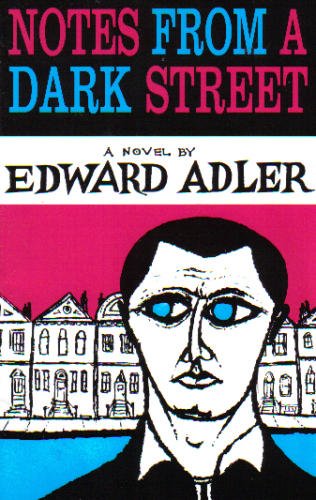In New York, people of all sorts freely mix with each other; but only slightly do they thaw and melt into a common pool of humanity. Edward Adler: Notes From a Dark Street. 1962. ….Martyrdom and suffering recounted in some seemingly absurd, wild and often pessimistic tales as if recounted by a Lower East Side Henry Fielding or William Dafoe. Here, suffering is equated to a kind of minimalist species of theatricality and ritual- think the Velvet Underground at a more Saul Bellowish level- without the intellectual pretension of af an Allen Ginsberg; these peolpe have Howl and Kaddish in their DNA already, stuck on an urban raft of the Medusa their personal damnation is an act of rebellion and the open seas as urban ghetto reflect the psychological tortures with which their souls are afflicted.
…BEFORE we are aware of anything else in “Notes from a Dark Street” we are acutely conscious of its language. The old women of the lower
East Side are “makeshift, amorphous, possessing no logic of genesis.” One of the ladies is “acrackle with credulity.” The hero and narrator, Barney Yago, is portrayed in a letter “under a tide of hyperbole.” And in a description of Judge Merchant we get a pithy summation of the characteristic rhetorical effect of Mr. Adler’s first novel: “Dapper, high collared, powerfully cuffed, he was given, in this day and age, to sleeve garters, to buttonhole sprouts and piped lapels, a magnifying glass on a ribbon, a platinum chain and pendant, Melachrinos, a snuffbox under
a seal of justice . . . an Indian head on a quadrangular ring, fingernail moons and bayrum, tweed spats, etc.” The catalogue is endless. The novel is an exhibition of rhetorical virtuosity….

---With his most recent show, the New York-born Montreal-based artist continues to produce memorable and engaging works of art that thoughtfully and intelligently dialogue with the history of art. This time Hannah challenged Théodore Géricault’s Raft of the Medusa (1819).---Read More:http://www.theartblog.org/2009/11/adad-hannah-in-montreal/
The criticism at the time, is actually a strength; the anti-modernism of taking hacks and swipes at form; cracking the window dressing and getting to the kernel of damnation as an act of rebellion where the individual is traumatized, panicked while trying to escape the inferno to which they are trapped; if one is stuck in a symbolic oicture of hell; are the haunted sounds of the damned and tortured requited to sing in tune like a Coca Cola commercial?
…Unfortunately, Mr. Adler’s technique is uncertain and his “notes”—to shift the metaphor for a moment—are played on an instrument badly out of tune. The characters conform to a special type. They are all plagued by an incurable jauntiness, which immediately expresses itself in the curious speech of the novel. (The jauntiness, the eccentricity are particularly infelicitous because they are not animated by humor.) The Talmudic scholar who had suffered in Auschwitz, the indescribable Irish janitor, the owner of the iron-works plant speak the same language in the same tone of voice as if the supposed differences in temperament and background were outmoded conventions of characterization. Nor is the “dark street” present in any significant way. …
It does seem absurd and clearly futile, like bugs stuck in a jar, but there is nonetheless a smoldering ember of self-respect, pride and personal dignity that could one day explode out its matrix, like touching the button to move a wall and escape the labyrinth of the Egyptian pyramid. A kind of Exodus that could ignite into something illuminated and substantial.
…The filth and reek of the street, the cramped apartments, the combustible atmosphere: they are finally irrelevant to the garrulousness of Mr. Adler’s sages. And without exception his characters are sages. Baron, the ironmaster, exclaims with typical…Read More:http://www.unz.org/Pub/SaturdayRev-1962jan20-00021a02?View=PDF
All of the categories of sin defined by Dante are present; Part Two of the novel consists of thirty-four cantos, each representing a corresponding one in The Inferno. Adler even contrived to pay tribute to Dante and Joyce, at the same time punning on their histories and, through the medium of his own purposefully degraded story, reflecting the degradation of his own version of the twentieth-century.
ADDENDUM:
…philosophical irrelevance: “Do you know what vouth is? Panic and arrogance. That’s all we ever get to know about being young. Pani
d arrogance. Which is nothing.” The novel tries unsuccessfully here and elsewhere for the note of pathos. From time to time there is an outcry of indignation abovit the inhumanity of the city; a Utopian plan is conceived to transform it into a human and natural place. But the indignation and the Utopian dream are without any genuine emotional resonance.
I have said nothing of the story, and indeed this is one of Mr. Adler’s main troubles. He is still the novelist in search of a story (what we have here are notes), and until he finds the story that he must tell it is doubtful that we will get anything more from him than the rhetorical bric-a-brac or debris that he has given us in this novel. His information, acquired in various jobs as fur worker, technical writer, draftsman,
grocer, etc., is considerable, but it doesn’t become art until it has been animated by imagination. There is an occasional scene that almost makes it— for instance, the description of Helm teaching his dead son blade-grinding— but such scenes are the promise of something better than the novel offers.Read More:http://www.unz.org/Pub/SaturdayRev-1962jan20-00021a02?View=PDF
——————————-









 COMMENTS
COMMENTS



